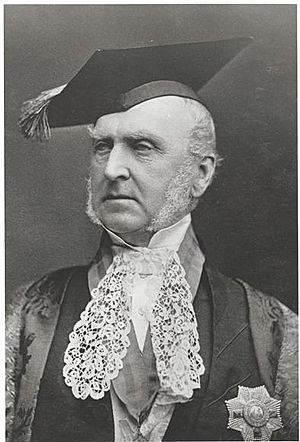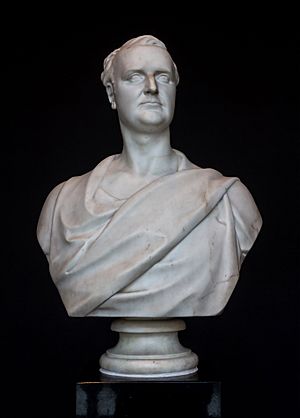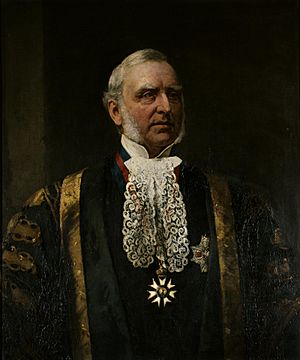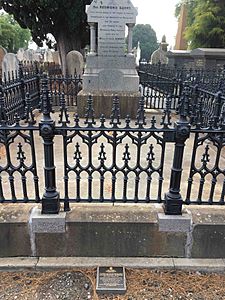Redmond Barry facts for kids
Quick facts for kids
Redmond Barry
|
|
|---|---|
 |
|
| 1st Chancellor of the University of Melbourne | |
| In office 1853–1880 |
|
| Personal details | |
| Born | 7 June 1813 Kilworth, Ireland |
| Died | 23 November 1880 (aged 67) Melbourne, Colony of Victoria |
| Occupation | Chancellor, judge |
Sir Redmond Barry (born June 7, 1813, died November 23, 1880) was an important judge in Victoria, Australia. He was born in Ireland and moved to Australia when it was still a group of British colonies. Barry was the very first leader, called the Chancellor, of the University of Melbourne. He held this job from 1853 until he passed away in 1880. Many people remember him for being the judge who sentenced the famous bushranger Ned Kelly to death.
Contents
Early Life and Education
Redmond Barry was the third son of Henry Green Barry, a high-ranking army officer, and Phoebe Drought. He grew up with five brothers and six sisters near Kilworth, County Cork, Ireland. He went to a military school called Hall Place in England.
After returning to Ireland in 1829, he could not join the army. So, he decided to continue his education on his own. He studied classic writers and translated their works. He also read many other books, both old and new.
In 1832, he started studying at Trinity College Dublin. He earned his Bachelor of Arts degree in 1835. In 1838, he became a lawyer in Dublin. After his father died, Barry decided to move to Australia. He sailed to Sydney, which was the main city of the British colony of New South Wales.
Life and Work in Australia
Barry arrived in New South Wales in April 1837 and was allowed to practice law there. After two years in Sydney, he moved to Melbourne. He arrived in the new Port Phillip Settlement on November 13, 1839. Melbourne became the city he was most connected with.
In 1841, Barry worked as a defense lawyer for two Indigenous men, Tunnerminnerwait and Maulboyheenner. They were on trial for murder. Barry argued that the British government might not have the right to judge Aboriginal people who were not citizens. He also said the evidence against them was not strong. Despite his efforts, the two men were found guilty. They were executed on January 20, 1842. They were the first people to be legally executed in Victoria.
After working as a lawyer for several years, Barry became a commissioner for the Court of Requests. In 1851, the Port Phillip district became its own colony called Victoria. Barry was then made the first Solicitor-General of Victoria. This meant he had a seat in both the Legislative and Executive Councils, which helped make laws and run the government. In 1852, he became a judge of the Supreme Court of Victoria. He also served as acting Chief Justice and Administrator of the government at different times.
Barry was well-known for helping his community. He convinced the government to spend money on public projects, especially for education. He played a key role in starting the Royal Melbourne Hospital (1848), the University of Melbourne (1853), and the State Library of Victoria (1854). He was the first leader, or chancellor, of the university until he died. He also led the group that managed the State Library. He was also the first President of the Ballarat School of Mines (1870), which is now Federation University Australia.
In 1855, Barry was the judge for the trials of the miners involved in the Eureka Rebellion. All thirteen miners were found not guilty.
In 1857, Barry led the investigation into the death of Inspector-General John Giles Price. Price was killed by a group of convicts. Seven of the convicts were found guilty and sentenced to death. These seven men were executed at Melbourne Gaol over three days in April.
Barry also led the committee for the Victorian Intercolonial Exhibition in Melbourne. He represented Victoria at big exhibitions in London (1862) and Philadelphia (1876). He was given the title of knight bachelor in 1860. In 1877, he was made a Knight Commander of the Order of St Michael and St George (KCMG).
Barry and the Kelly Gang
In October 1878, Judge Barry was in charge of a case at Beechworth court. Mrs. Ellen Kelly, Ned Kelly's mother, and two men were accused of helping someone try to murder a police officer. After sentencing Mrs. Kelly to three years of hard labor, Barry said that if her son Ned were there, he would make an example of him. He said he would give Ned fifteen years in prison.
In 1880, Barry was the judge for the final trial of Ned Kelly himself. Kelly was tried and found guilty of murdering three other police officers. The trial and sentencing have been written about in many books and articles. When Barry sentenced Kelly to death, he used the traditional words, "May God have mercy on your soul." According to records, Kelly replied, "I will go a little further than that, and say I will see you there when I go." Barry died only twelve days after Kelly's execution. Doctors said he died from lung problems and a carbuncle (a type of skin infection) on his neck.
How Barry Helped Libraries
Sir Redmond Barry helped create the Supreme Court Library in Melbourne. He was also the main person behind starting the Melbourne Public Library. As a lawmaker, he also supported the Parliamentary Library. In 1854, he arranged for the Governor, Sir Charles Hotham, to lay the foundation stones for the University of Melbourne, the Melbourne Public Library, and the Sunbury Industrial School all on the same day.
Sir Redmond Barry almost single-handedly planned the Melbourne Public Library building and what would go inside it. He was very involved, even writing how to choose and buy books. He even helped put books on the shelves for the Library's opening in 1856. In 1862 and again from 1877 to 1878, he traveled to Europe, England, and America. He bought books and pictures for the University, Law, and Public Libraries, and for the Art Gallery. As the head of the Board of Trustees, he started "traveling libraries" and supported keeping the library open for longer hours.
Books and reading were very important to Barry's own learning. He wanted other people to have the same chances. He supported the Melbourne Public Library, the Law Library, and Mechanic Institutes because he believed everyone should have free access to libraries.
Personal Life
Barry never married. However, he had four children with a woman named Louisa Barrow. He recognized all his children and supported them.
In August 1841, he was involved in a duel with a farmer named Peter Snodgrass. Snodgrass's pistol fired too early. Barry then fired his own pistol harmlessly into the air.
Death
The Argus newspaper reported that Barry had been sick with diabetes for about ten years. When he came back from his trip to Europe and America, it was clear the disease had affected him more. On November 15, he got a carbuncle on his neck.
His doctor told Sir Redmond to rest from work right away. But he did not want to, and he kept going to court until he had to stop. Dr. Gunst was always with him, but Barry did not think his illness was very serious. He became restless, and it was decided he needed a nurse to care for him all the time. Despite these efforts, Barry caught a cold, and his left lung became very congested. Dr. Gunst and another doctor, Dr. Teague, decided that his condition was hopeless. The lung problem, along with his weakness from diabetes, caused his death.
Barry loved collecting books. He left a large collection of books that were sold after he died.
Memorials and Legacy

The State Library of Victoria has a reading room named after Sir Redmond Barry. He was the first head of the Board of Trustees for the Melbourne Public Library. A statue of Barry was placed in front of the library in 1887.
The University of Melbourne, where he was the first Chancellor, has a building named the Redmond Barry building. There is also a plaque marking where Sir Redmond Barry lived near Josephine Avenue and High Street Road in Mount Waverley. The University of Melbourne also gives a special title, "Redmond Barry Distinguished Professor," to professors who show excellent research and leadership.
The Australian Library and Information Association gives its highest award to people who are not members. It is called the Redmond Barry Award. This award recognizes great service or promotion of libraries and information services.
Portrayals in Film
Barry has been shown as a character in several movies and TV shows about Ned Kelly:
- In the 1970 movie Ned Kelly, he was played by Frank Thring.
- In the 1977 TV drama The Trial of Ned Kelly, he was played by John Frawley.
- In the 1980 miniseries The Last Outlaw, he was played by David Clendinning.
- He also had a small role in the movie Mad Dog Morgan, played by Peter Collingwood.
See also
- Judiciary of Australia
- List of Judges of the Supreme Court of Victoria




